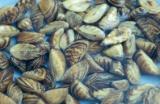 © Louis Vest (LandScope Texas Banner)
© Louis Vest (LandScope Texas Banner)

Invasive Species
Invasive species are a leading threat to native biodiversity and natural habitats across the U.S., and Texas is no exception. An invasive species is one that has been introduced into a new area and begins to spread or reproduce quickly, causing damage to native species and their habitats. Not all non-native species are invasive, but those that are can cause tremendous harm to natural systems, causing both environmental and economic harm.
In Texas, some of the worst invasive species include the Zebra mussel, the aquatic fern giant salvinia, and red fire ants.
The Zebra mussel has invaded many Texas lakes and waterways, and they can cause severe declines in native mussels, fish, and other aquatic dependent species. The Zebra mussels take in phytoplankton, leaving little of this important food source behind for native species. They can damage boats, increase water temperature in lakes, and even threaten water supplies by clogging pipelines.
Giant salvinia (Salvinia molesta) is an aquatic fern that floats in dense mats on the surface of streams, lakes, and ponds. Giant salvinia spreads rapidly and the dense mat it forms shades out native species and can change the ecology of the waterways it invades.
Red fire ants are tiny, but extremely aggressive and destructive in areas they invade. Without natural enemies, their populations grow quickly in size, and they alter the composition of natural communities. They compete with native animals for food and habitat, and have negative impacts on ground-nesting birds and other species.
Many organizations in Texas work together to educate the public and do research on invasive species control and prevention.
For more information, see:
Featured Article
-
Saltcedar Beetle and the Rio Grande
by Kristi Drake
Saltcedar beetles were introduced along a stretch of the Rio Grande in 2009 as a biological control for saltcedar bush, an invasive species that is drying up desert springs and arroyos and degrading fish and wildlife habitat.



